-
 Trichomoniasis: Diagnostic Methods Challenges and Nucleic Acid Amplification Techniques for Improved Detection
Trichomoniasis: Diagnostic Methods Challenges and Nucleic Acid Amplification Techniques for Improved Detection -
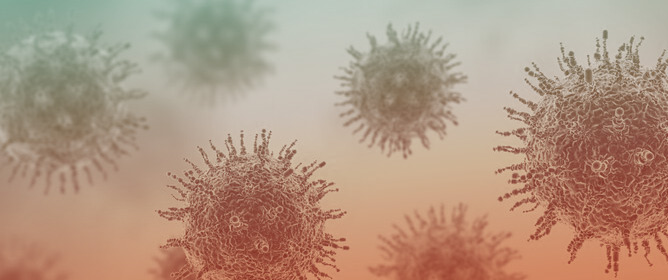 The TLR2 Arg753Gln Polymorphisms in The Netherlands: Can Number of Sexual Contacts Indicate Protection against Syphilis?
The TLR2 Arg753Gln Polymorphisms in The Netherlands: Can Number of Sexual Contacts Indicate Protection against Syphilis? -
 State of Knowledge on Sexually Transmitted Infections
State of Knowledge on Sexually Transmitted Infections -
 Screening for HPV-Related Oropharyngeal Cancer in Gay and Bisexual Men: Acceptability and Predicting Possible Use of “Oral Selfies” by Smartphone as a Secondary Prevention Approach
Screening for HPV-Related Oropharyngeal Cancer in Gay and Bisexual Men: Acceptability and Predicting Possible Use of “Oral Selfies” by Smartphone as a Secondary Prevention Approach -
 Racial Disparities in STI Burden
Racial Disparities in STI Burden
Journal Description
Venereology
Venereology
is an international, peer-reviewed, open access journal on venerology research published quarterly online by MDPI.
- Open Access— free for readers, with article processing charges (APC) paid by authors or their institutions.
- Rapid Publication: first decisions in 16 days; acceptance to publication in 5.8 days (median values for MDPI journals in the second half of 2023).
- Recognition of Reviewers: APC discount vouchers, optional signed peer review, and reviewer names published annually in the journal.
Latest Articles
Reemergence of Congenital Syphilis in the United States: A Narrative Review
Venereology 2024, 3(2), 89-95; https://doi.org/10.3390/venereology3020007 - 18 Apr 2024
Abstract
Congenital syphilis, a preventable and deadly disease, has witnessed an alarming resurgence in the US in recent years, posing a vital public health challenge. Historically, effective prevention and treatment strategies led to a decline in congenital syphilis, and some believed that it could
[...] Read more.
Congenital syphilis, a preventable and deadly disease, has witnessed an alarming resurgence in the US in recent years, posing a vital public health challenge. Historically, effective prevention and treatment strategies led to a decline in congenital syphilis, and some believed that it could be eradicated. However, inadequate prenatal care, limited access to healthcare services, and gaps in syphilis screening programs have led to a resurgence of congenital syphilis. In this narrative review, we aim to highlight the key factors contributing to the reemergence of congenital syphilis and its implications on maternal and child health.
Full article
Open AccessArticle
State of Knowledge on Sexually Transmitted Infections among Health Professionals and Health Sciences Students in France
by
Marine Chlebus, Laurence Boyer, Sébastien Doerper, Tristan Hergot and Mihayl Varbanov
Venereology 2024, 3(2), 63-88; https://doi.org/10.3390/venereology3020006 - 09 Apr 2024
Abstract
►▼
Show Figures
The burden of morbidity and mortality caused by sexually transmitted infections (STIs) has serious consequences on the quality of life of populations. Nowadays, despite numerous prevention campaigns, sexually transmitted infections have been on the rise in France for several years. It remains important
[...] Read more.
The burden of morbidity and mortality caused by sexually transmitted infections (STIs) has serious consequences on the quality of life of populations. Nowadays, despite numerous prevention campaigns, sexually transmitted infections have been on the rise in France for several years. It remains important to transmit the right information in order to better educate and support patients. Where then remains the problem, and how can we improve the involvement and awareness of the general population regarding the risks of these STIs? It is imperative to work upstream on the training of health professionals and students because they are the first interlocutors and the only ones to transmit the knowledge acquired during their initial training to the individuals concerned. The objective of this work is to identify the areas where health professionals and students do not yet have all the notions acquired via a multiple-choice questionnaire on the different STIs and their major characteristics. These results will contribute to the implementation of additional training at the Health Centers in France.
Full article
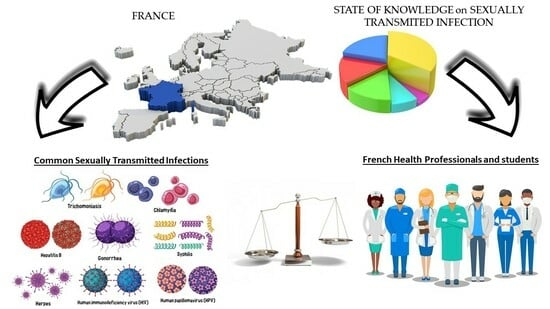
Graphical abstract
Open AccessArticle
Economics of HIV Prevention: Understanding the Empirical Intersection between Commodity Price Shocks, Health Spending and HIV Infections in Developing Countries
by
Cyprian Mostert
Venereology 2024, 3(1), 51-62; https://doi.org/10.3390/venereology3010005 - 21 Mar 2024
Abstract
►▼
Show Figures
Background: This study seeks to understand the empirical nature of macro-financial factors associated with the worsening of HIV infections and the risks that need to be carefully monitored for a sustainable improvement in HIV outcomes as developing countries seek to achieve the United
[...] Read more.
Background: This study seeks to understand the empirical nature of macro-financial factors associated with the worsening of HIV infections and the risks that need to be carefully monitored for a sustainable improvement in HIV outcomes as developing countries seek to achieve the United Nations 95-95-95 targets. Methods: The author used a panel VAR model to study the long-term endogenous relationships between percentage changes in the annual spot price of the most traded commodities, GDP per capita, health spending, and the HIV infection rate of developing countries. Results: The author discovered that shocks of global commodity prices negatively impact GDP per capita, real government health spending, and real private health spending. These shocks have adverse spillover effects characterized by worsening HIV infections. The reactions from price shocks suggest that GDP per capita contract immediately when a commodity price shock hits developing economies. Real government health spending and real private health spending also contract instantly. HIV infections begin worsening three years after the shock in the energy and precious metal blocks of countries. HIV infections also begin to worsen two years after shocks in the agricultural block of counties. These impacts are statistically significant and can potentially reverse the positive HIV infection gains achieved in the previous years. Emergency funds, insurance schemes, and international aid for HIV need to discharge more funds to counter these shocks. Conclusions: There is a significant risk of reversing HIV infection outcomes arising from commodity price shocks. Funding agencies must protect HIV prevention services from global macro-economic shocks as countries move closer to the United Nations 95-95-95 targets.
Full article
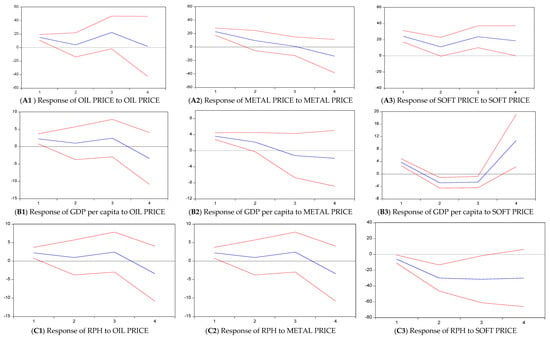
Figure 1
Open AccessReview
From Wet Mount to Nucleic Acid Amplification Techniques: Current Diagnostic Methods and Future Perspectives Based on Patenting of New Assays, Stains, and Diagnostic Images for Trichomonas vaginalis Detection
by
Fernanda Gomes Cardoso, Mariana Dicki Freitas, Tiana Tasca and Graziela Vargas Rigo
Venereology 2024, 3(1), 35-50; https://doi.org/10.3390/venereology3010004 - 18 Mar 2024
Abstract
Trichomoniasis is the most common non-viral sexually transmitted infection (STI) in the world. The estimated global prevalence in 2016 was 156 million adults aged 15–49. However, these data are underestimated, since the most used diagnostic method is the wet mount, which has low
[...] Read more.
Trichomoniasis is the most common non-viral sexually transmitted infection (STI) in the world. The estimated global prevalence in 2016 was 156 million adults aged 15–49. However, these data are underestimated, since the most used diagnostic method is the wet mount, which has low sensitivity, the information regarding the estimated duration of infection is limited and there is evidence of undiagnosed asymptomatic cases in both sexes. Currently 80% of cases—including both sexes—are asymptomatic, which makes the disease silent and chronic in course, leading to complications. The aim of this review was to discuss the diagnostic methods for T. vaginalis detection that are currently available and applicable in the clinical laboratory routine. Overall, nucleic acid amplification techniques are the best option for T. vaginalis detection, with higher sensitivity and specificity than other tests. Although these techniques present higher cost, their implementation should be supported to ensure correct trichomoniasis diagnosis and treatment beyond contributing to questions on epidemiology and control.
Full article
(This article belongs to the Special Issue New Advances in Management and Treatment of Sexually Transmitted Infections)
►▼
Show Figures
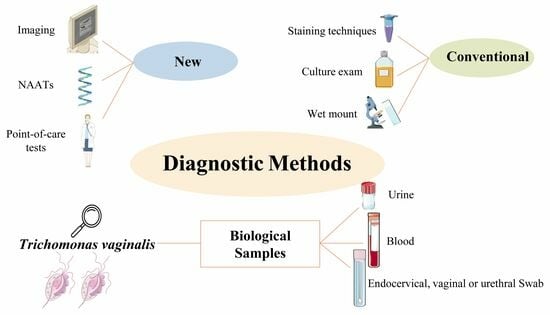
Graphical abstract
Open AccessArticle
The Arg753Gln Polymorphisms in Toll-like Receptor 2 in a Syphilis-Infected and Control Population in The Netherlands: Can Differences in the Number of Self-Reported Sexual Contacts Indicate Protection against Syphilis?
by
Eliška Vrbová, Helene Zondag, Sylvia Bruisten and David Šmajs
Venereology 2024, 3(1), 26-34; https://doi.org/10.3390/venereology3010003 - 20 Feb 2024
Abstract
The Arg753Gln polymorphism in Toll-like receptor 2 has been associated with an increased risk of bacterial infections as well as with protection from the late stages of Lyme disease and the acquisition of syphilis. In this study, we determined the presence of this
[...] Read more.
The Arg753Gln polymorphism in Toll-like receptor 2 has been associated with an increased risk of bacterial infections as well as with protection from the late stages of Lyme disease and the acquisition of syphilis. In this study, we determined the presence of this polymorphism in samples collected from men having sex with men/men with women in the Amsterdam Cohort Studies. The presence of the polymorphism was determined by nested PCR, followed by Sanger sequencing. A set of 90 syphilis-seronegative individuals was compared to 95 syphilis-diagnosed participants. A polymorphism allele frequency of 3.9% was found in the control group and 2.63% in the syphilis case group, respectively. None of the individuals showed a homozygous Arg753Gln polymorphism. The number of self-reported sexual contacts was higher in the group of syphilis patients compared to the control group (p = 0.0063). Moreover, in the syphilis case group (n = 49), participants heterozygous for the TLR2-Arg753Gln reported higher numbers of sexual contacts (p = 0.037) compared to wild-type homozygotes. Our findings suggest a possible protective effect of TLR2-Arg753Gln in the acquisition of syphilis. In addition, the determination of the number of self-reported sexual contacts can be used in an evaluation of the protective effect of polymorphism in a population with a low prevalence of it.
Full article
(This article belongs to the Special Issue Exclusive Papers of the Editorial Board Members of Venereology)
►▼
Show Figures
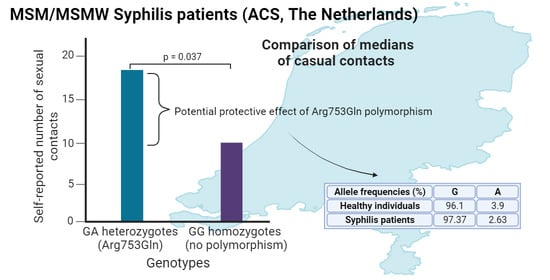
Graphical abstract
Open AccessCommunication
The Enhanced Activity of a Plant Mixture from the Brazilian Caatinga Biome against Venereal Trichomonads Confirms the Traditional Use
by
Nícolas Luiz Feijó Silva, Patrícia de Brum Vieira, Márcia Vanusa da Silva, Alexandre José Macedo and Tiana Tasca
Venereology 2024, 3(1), 15-25; https://doi.org/10.3390/venereology3010002 - 06 Jan 2024
Abstract
Women living in the semi-arid region of Caatinga in the northeast of Brazil report the use of plant mixtures to treat diseases in the genitourinary tract. Plant extracts were obtained from barks to simulate traditional use. The anti-trichomonads activity as well as the
[...] Read more.
Women living in the semi-arid region of Caatinga in the northeast of Brazil report the use of plant mixtures to treat diseases in the genitourinary tract. Plant extracts were obtained from barks to simulate traditional use. The anti-trichomonads activity as well as the cytotoxic effect of plant extracts were tested. Herein, we confirmed this traditional knowledge by testing plants aqueous extracts against Trichomonas vaginalis and Tritrichomonas foetus, the etiologic agents of human and bovine trichomoniasis. All plant extracts were active individually against at least one trichomonads species except for Prosopis juliflora and Amburana cearensis. Cedrela sp. was the most active against both trichomonads species. Finally, a mixture of plants used in traditional medicine was evaluated for activity. A mixture containing extracts of the plants Ximenia americana, Anadenanthera colubrina var. cebil, Myracrodruon urundeuva, Sideroxylon obtusifolium, and Amburana cearensis was active against the two trichomonads. This finding confirms the traditional practice by women living in the Caatinga region of using a mixture of plants during sitz baths to treat vaginal infections. Altogether, these results highlight the ethnopharmacological use of Cedrela sp. and of the plant mixture for the treatment of venereal diseases by Caatinga residents.
Full article
(This article belongs to the Special Issue New Advances in Management and Treatment of Sexually Transmitted Infections)
►▼
Show Figures
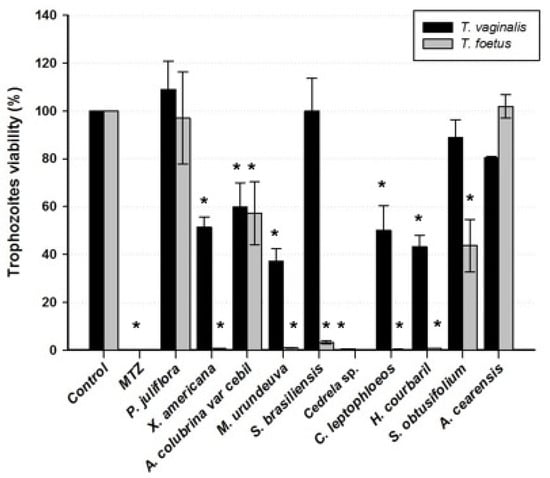
Figure 1
Open AccessReview
Doxycycline in STI Prophylaxis—A Literature Review
by
Andrzej Załęski, Mariusz Sapuła, Agnieszka Lembas and Alicja Wiercińska-Drapało
Venereology 2024, 3(1), 1-14; https://doi.org/10.3390/venereology3010001 - 29 Dec 2023
Abstract
Background: Since the implementation of pre-exposure prophylaxis (PrEP) in HIV prevention, a significant increase in the prevalence of other sexually transmitted infections (STIs) has been reported, especially among men who have sex with men (MSM). Doxycycline is being examined as a potential pharmacological
[...] Read more.
Background: Since the implementation of pre-exposure prophylaxis (PrEP) in HIV prevention, a significant increase in the prevalence of other sexually transmitted infections (STIs) has been reported, especially among men who have sex with men (MSM). Doxycycline is being examined as a potential pharmacological agent in preventing these infections. This review aims to summarize available data on the effectiveness and potential side effects of doxycycline for the prevention of bacterial STIs. Methods: We reviewed the National Library of Medicine and the National Center of Biotechnology Information in order to find clinical trials and relevant observational studies regarding doxycycline usage in STI prophylaxis. Results: Doxycycline prophylaxis reduced the risk of acquiring chlamydia, syphilis, and, in a majority of the trials, the risk of gonorrhea. The clinical trials on doxycycline STI prophylaxis were underpowered to determine if doxycycline promotes the selection of resistance in Neisseria gonorrhoeae and Chlamydia trachomatis. Additionally, no serious side effects of this preventive measure have been reported. None of the studies aimed to compare the efficacy of post- and pre-exposure prophylaxis of STDs with doxycycline. Conclusions: The preliminary results regarding STI prophylaxis with doxycycline seem to be promising. Further research is needed to determine the potential risk of doxycycline prophylactic prescription.
Full article
(This article belongs to the Special Issue New Advances in Management and Treatment of Sexually Transmitted Infections)
Open AccessArticle
Screening for HPV-Related Oropharyngeal Cancer in Gay and Bisexual Men: Acceptability and Predicting Possible Use of “Oral Selfies” by Smartphone as a Secondary Prevention Approach
by
Michael W. Ross, Sarah L. Bennis, Niles Zoschke, Brian R. Simon Rosser, Cyndee L. Stull, Alan G. Nyitray, Samir S. Khariwala, Mark Nichols, Charlene Flash and Michael Wilkerson
Venereology 2023, 2(4), 180-193; https://doi.org/10.3390/venereology2040016 - 07 Dec 2023
Abstract
Oropharyngeal cancers (OPCa) caused by HPV have emerged as one of the leading causes of malignancies caused by HPV infection. They are also significantly more likely to occur in males and in people with a history of oral sex with multiple partners. Gay
[...] Read more.
Oropharyngeal cancers (OPCa) caused by HPV have emerged as one of the leading causes of malignancies caused by HPV infection. They are also significantly more likely to occur in males and in people with a history of oral sex with multiple partners. Gay and bisexual men are disproportionately affected by HPV-positive oropharyngeal cancers. We studied 1699 gay and bisexual men on 2 major dating sites in the US to assess their knowledge about HPV-related OPCa, attitudes toward screening for it, beliefs about oropharyngeal cancer screening based on the Health Belief Model, and attitudes toward possible screening approaches for OPCa. Knowledge on a 12-item scale was low, with a median of 5 items correct: 72% knew of the benefits of HPV vaccination. Significant predictors of needing OPCa screening included perception of risk for OPCa, seeing it as severe, having lower barriers, fewer reasons to avoid screening, higher knowledge, and being HPV vaccinated were significant predictors, explaining half the total variance. Most participants would accept routine, virtual/online doctor or dental appointments, and over half would accept an in-person screening. Nearly two-thirds stated that they would accept getting checked for OPCa if they could do self-screening at home, and half were prepared to use an online screening tool or app, where they could take an “oral selfie” and send it to a healthcare provider for examination. One-third stated that they would trust the results of a home screening completed by themselves and posted to a website equally as cancer screening completed online by a healthcare provider. Data indicate that despite low OPCA knowledge levels, the risk of HPV-associated OPCa was known. Being at personal risk and having knowledge of disease severity had 70% of the sample thinking about, or preparing to get, screening. Self-screening by a smartphone “oral selfie” transmitted to a screening website was acceptable to many gay and bisexual men, and online screening by a doctor or dentist was acceptable to most. OPCa screening in this population using electronic technology, together with the increasing incidence of HPV-associated OPCa in gay and bisexual men, brings together an opportunity to detect OPCa early.
Full article
(This article belongs to the Special Issue Exclusive Papers of the Editorial Board Members of Venereology)
Open AccessBrief Report
Racial Disparities Associated with Increased Burden of Sexually Transmitted Infections in North Carolina, Southeastern United States
by
Peter D. Ahiawodzi, Cydney Nicholson, Briana Williams and Dorothea K. Thompson
Venereology 2023, 2(4), 173-179; https://doi.org/10.3390/venereology2040015 - 01 Nov 2023
Abstract
Sexually transmitted infections (STIs) constitute a major public health issue in the United States. North Carolina (NC) in the southeastern U.S. ranks among the highest in STI incidence. We aimed to describe the incidence rates and identify potential risk factors of STIs in
[...] Read more.
Sexually transmitted infections (STIs) constitute a major public health issue in the United States. North Carolina (NC) in the southeastern U.S. ranks among the highest in STI incidence. We aimed to describe the incidence rates and identify potential risk factors of STIs in NC. The STI data reported by the NC Department of Health and Human Services for 2018 were compiled for chlamydia, gonorrhea, syphilis, and HIV infections for all 100 NC counties. Linear regression modeling was used to assess the association of STIs with predefined county-level variables. The mean STI incidence rates per 100,000 persons were highest for chlamydia (592.43 ± 30.02), followed by gonorrhea (212.06 ± 13.75), HIV (12.66 ± 0.947), and syphilis (3.33 ± 0.439). For chlamydia, higher risk was significantly associated with income (β = −0.008, SE = 0.003; p = 0.006), education (some college; β = 10.02, SE = 3.15, p = 0.002), race (Black; β = 12.17, SE = 1.57, p < 0.0001), and number of truck stops (β = 20.20, SE = 6.75, p = 0.004). The same variables, except for education, were associated with higher gonorrhea risk. Only race (being Black) was significantly associated with higher syphilis risk. Racial disparities in STI burden were significant, with race (being Black) constituting a risk factor for all four STIs. Interventions targeted to identified risk factors may help to reduce the STI burden in NC.
Full article
Open AccessArticle
Seroprevalence of Human Cytomegalovirus Infection among HIV Patients in Edo State, Southern Nigeria
by
Ifueko Mercy Moses-Otutu, Nosawema Franklyn Ojo, Ogochukwu Janet Nzoputam and Chimezie Igwegbe Nzoputam
Venereology 2023, 2(4), 164-172; https://doi.org/10.3390/venereology2040014 - 30 Oct 2023
Abstract
►▼
Show Figures
Background: Human cytomegalovirus (HCMV) is an important pathogen in immunocompromised individuals where it causes end organ diseases leading to increased morbidity and mortality. The aim of this study was to determine the prevalence of HCMV infection and its associated risk factors among HIV
[...] Read more.
Background: Human cytomegalovirus (HCMV) is an important pathogen in immunocompromised individuals where it causes end organ diseases leading to increased morbidity and mortality. The aim of this study was to determine the prevalence of HCMV infection and its associated risk factors among HIV patients in Edo State, Nigeria. Methods: A total of 150 HIV patients consisting of 80 males and 70 females were enrolled for this study. About 4 mL of venous blood was aseptically collected from each participant by venipuncture and was centrifuged to obtain serum. The serum was screened by ELISA for HCMV IgG and IgM antibodies. Results: The results obtained were analyzed using SPSS version 20 for data analysis. An overall prevalence of 32.7% for HCMV IgM antibodies was recorded among the HIV patients. Males had a higher prevalence of 55.1% HCMV IgM antibodies than their female counterparts with 44.9% HCMV IgM antibodies. HCMV was more prevalent among the age group <19 years (51.0%), followed by the age group 20–39 years (30.6%), while the age groups >60 years, and 40–59 years recorded a prevalence of 12.2% and 6.1%, respectively. Conclusions: The co-occurrence of HCMV IgG and IgM antibodies, religion and location significantly influenced the acquisition of HCMV infection among HIV patients. Integrating HIV prevention by spreading awareness and early diagnosis of HCMV is key to reducing complications from these viral infections in HIV disease patients.
Full article
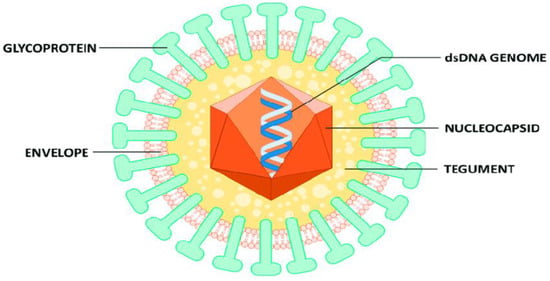
Figure 1
Open AccessReview
Advancing Syphilis Research: Exploring New Frontiers in Immunology and Pharmacological Interventions
by
James Oluwagbamigbe Fajemiroye, Andre Luis Elias Moreira, Célia Regina Malveste Ito, Elson Alves Costa, Rafaella Misael Queiroz, Ogbu John Ihayi, Caroline Vitória Moreira, Rafael Fernandes Costa, Claudia Carneiro Teixeira, Miguel Júnior Sordi Bortolini and Osmar Nascimento Silva
Venereology 2023, 2(4), 147-163; https://doi.org/10.3390/venereology2040013 - 22 Oct 2023
Abstract
►▼
Show Figures
In recent years, the global resurgence of syphilis has posed significant challenges to public health. This sexually transmitted infection, caused by the bacterium Treponema pallidum, can have severe consequences if left untreated, including neurological and cardiovascular complications. Diagnosing syphilis is complex due
[...] Read more.
In recent years, the global resurgence of syphilis has posed significant challenges to public health. This sexually transmitted infection, caused by the bacterium Treponema pallidum, can have severe consequences if left untreated, including neurological and cardiovascular complications. Diagnosing syphilis is complex due to its diverse clinical presentations, necessitating a multifaceted approach, including serological, molecular, and direct techniques such as dark-field microscopy. Penicillin remains the primary and effective treatment, but emerging macrolide-resistant strains have spurred investigations into alternative antibiotics. Syphilis vaccine development faces unique hurdles, yet promising strategies are under investigation. Targeted prevention strategies focus on high-risk populations such as men who have sex with men, pregnant women, and individuals with multiple sexual partners. The integration of syphilis services into primary healthcare enhances accessibility, early detection, and treatment. Innovative point-of-care diagnostics offer rapid, sensitive testing, while ongoing vaccine research holds the potential for long-term prevention. Addressing the global burden of syphilis requires a multifaceted approach, encompassing immunological advancements, innovative diagnostics, targeted prevention, and primary healthcare integration. Collaborative efforts between governments, healthcare systems, researchers, and communities are essential to effectively combat syphilis, striving toward a syphilis-free future that promotes better sexual health and overall well-being.
Full article
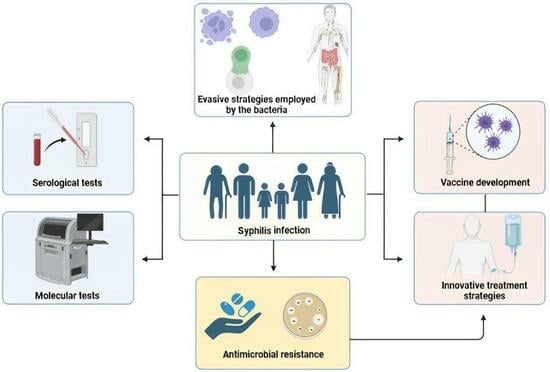
Graphical abstract
Open AccessArticle
Pangenome Analysis Reveals a High Degree of Genetic Diversity in Gardnerella vaginalis: An In Silico Approach
by
Andrei Giacchetto Felice, Eduarda Guimarães Sousa, Fabiana Vieira Dominici, Vasco Ariston de Carvalho Azevedo and Siomar de Castro Soares
Venereology 2023, 2(4), 132-146; https://doi.org/10.3390/venereology2040012 - 30 Sep 2023
Cited by 1
Abstract
►▼
Show Figures
The genus Gardnerella comprises Gram-variable, anaerobic, hemolytic, and non-motile bacilli, with four known species, where Gardnerella vaginalis is the main species responsible for bacterial vaginosis (BV). However, quantifying this species is challenging due to a lack of data and underreporting. Despite its significance,
[...] Read more.
The genus Gardnerella comprises Gram-variable, anaerobic, hemolytic, and non-motile bacilli, with four known species, where Gardnerella vaginalis is the main species responsible for bacterial vaginosis (BV). However, quantifying this species is challenging due to a lack of data and underreporting. Despite its significance, particularly for women, and the availability of several genomes in online databases, genomic analyses and studies on effective treatments still lack details. This study aimed to conduct bioinformatic analyses focused on pangenomics to investigate the complete gene repertoire of the species. Genomes of the bacterium available in online databases were used for comparative genomics, genomic plasticity, gene synteny, and pangenome prediction analyses. The results revealed considerable genome variability, indicating a highly diverse pangenome. The low number of genes in the core genome and similarity analysis confirmed this variability. Three pathogenicity islands, two resistance islands, and nine genomic islands were identified, suggesting horizontal gene transfer events during evolution. These findings underscore the need for sequencing new G. vaginalis genomes to better comprehend its variability and adaptation patterns.
Full article

Graphical abstract
Open AccessCase Report
Going Off-Script: Dilemmas in the Evaluation and Treatment of Syphilis in Four Patients
by
Benjamin Silverberg, Chad Sethman, Jonathan Williamson, Mary Craft, Melinda Sharon and Amie M. Ashcraft
Venereology 2023, 2(3), 124-131; https://doi.org/10.3390/venereology2030011 - 12 Sep 2023
Abstract
►▼
Show Figures
Syphilis is a sexually transmitted infection caused by the bacterium Treponema pallidum. Currently, rates of infection are increasing across all populations worldwide, with disproportionate impact on men who have sex with men, adolescents, and young adults. Syphilis is well-known for its variability
[...] Read more.
Syphilis is a sexually transmitted infection caused by the bacterium Treponema pallidum. Currently, rates of infection are increasing across all populations worldwide, with disproportionate impact on men who have sex with men, adolescents, and young adults. Syphilis is well-known for its variability in disease progression and clinical presentation, which complicates prompt and accurate diagnosis. Acute care settings have become the frontline in the battle against this syphilis surge, and providers must be prepared to recognize syphilis presentation, initiate appropriate testing, and establish contact tracing for individuals who may have been exposed. The purpose of this manuscript is to serve as a teaching tool for syphilis diagnosis and treatment, and we present four cases that showcase the risks and variable clinical presentation, discussing the challenges involved in managing each case. The authors then summarize key learning points related to diagnosis, treatment, and follow-up.
Full article
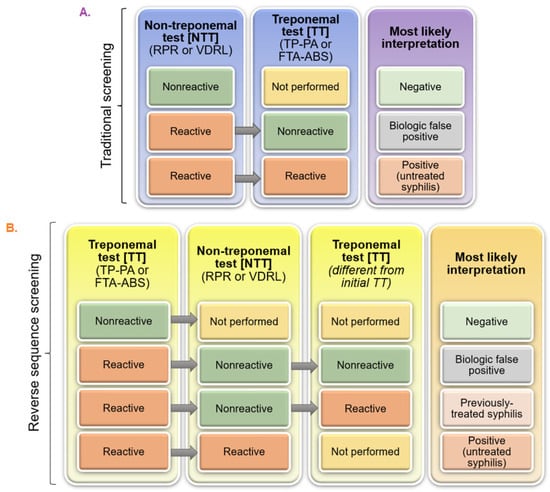
Figure 1
Open AccessArticle
“I Use Strawberry Flavoured Condoms during My Periods”: Safe Sex Practices and STI Screening Behaviours among Female Sex Workers in Gulu City, Uganda
by
Felix Bongomin, Winnie Kibone, Pebalo Francis Pebolo, Fiona Gladys Laker, Jerom Okot, Felix Ocaka Kaducu, Grace Madraa, Constantine Steven Labongo Loum, Silvia Awor, Agnes Napyo, David Musoke and Simple Ouma
Venereology 2023, 2(3), 108-123; https://doi.org/10.3390/venereology2030010 - 28 Aug 2023
Abstract
►▼
Show Figures
Background: Female sex workers (FSWs) are at a higher risk of contracting and transmitting HIV and other sexually transmitted infections (STIs). We aimed to explore the sexual behaviour, knowledge and attitudes towards STIs, barriers, support and intervention for STI screening. Methods: In this
[...] Read more.
Background: Female sex workers (FSWs) are at a higher risk of contracting and transmitting HIV and other sexually transmitted infections (STIs). We aimed to explore the sexual behaviour, knowledge and attitudes towards STIs, barriers, support and intervention for STI screening. Methods: In this community-based, concurrent quantitative–qualitative, exploratory mixed-methods study, we administered 87 semi-structured quantitative and six in-depth interviews to purposively select FSWs in Gulu City, Uganda. The qualitative methodology was based on descriptive phenomenology. Results: The quantitative study included 87 FSWs, with a median age of 28 years. Overall, 87.4% (n = 76) participants reported condom use during their last sexual encounter. Eighty-three (95.4%) participants were aware of their HIV status, with 6% (n = 5) reporting being HIV-positive. Seventy-six (87.4%) participants reported contracting at least one STI during sex work. In addition, 66.7% (n = 58) of the participants reported being screened for STIs in the past three months, with vulvovaginal candidiasis (55.3%, n = 42) and syphilis (32.9%, n = 25) being the most common STIs. However, only 2.3% (n = 2) of the participants reported current STIs symptoms. In the qualitative study, the main themes encompassed sexual behaviour, including condom-use negotiation strategies and challenges, as well as screening facilitators and barriers. Condom-use negotiation tactics involved leveraging health-risk information, increased charges for unprotected sex, and outright refusal. Complex challenges included limited agency in promoting safe sex due to economic reliance, vulnerability to violence, and difficulties in controlling the sexual environment. Facilitators for regular screening included social influences, emotional relief, established testing habits, and accessible clinics, while barriers encompassed cost, stigma, doubts about test accuracy, and inconvenient clinic hours. Conclusions: FSWs face significant vulnerabilities in Gulu City, Uganda, regarding STIs. While encouraging trends such as high HIV awareness and condom usage were observed, persistent challenges in STI screening, negotiation of safe sex practices, and access to prevention and treatment remain evident. To address these concerns, targeted interventions should be developed to enhance STI screening accessibility, empower sex workers with effective negotiation skills, and provide comprehensive support for STI prevention and treatment, thereby contributing to improved overall sexual health and well-being among this marginalized population.
Full article
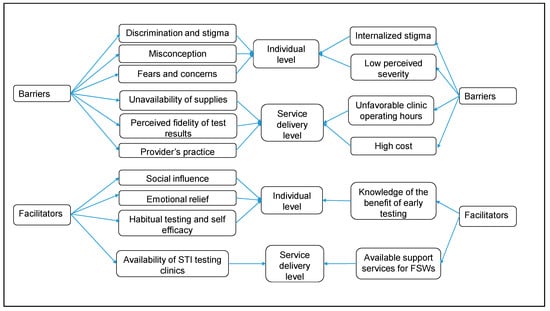
Figure 1
Open AccessArticle
Efficacy of a Multi-Level Pilot Intervention (“Harmony”) to Reduce Discrimination Faced by Men Who Have Sex with Men and Transgender Women in Public Hospitals in India: Findings from a Pre- and Post-Test Quasi-Experimental Trial among Healthcare Workers
by
Venkatesan Chakrapani, Smitha Nair, Sudharshini Subramaniam, Ketki Ranade, Biji Mohan, Ruban Nelson, Sajeesh T. Sivaraman, Murali Shunmugam, Jasvir Kaur, Shruta Rawat, Theranirajan Ethirajan, Chinmoyee Das, Shobini Rajan, Anoop Kumar Puri, Bhawani Singh Kushwaha, Bhawna Rao, Utpal Das, Vinita Verma and Neha Kapoor
Venereology 2023, 2(3), 86-107; https://doi.org/10.3390/venereology2030009 - 28 Jul 2023
Abstract
►▼
Show Figures
Reducing the stigma and discrimination faced by men who have sex with men (MSM) and transgender women (TGW) in healthcare settings is key to improving health outcomes. Using a one-group pre- and post-test design, we tested the efficacy of a theory-informed, multi-level pilot
[...] Read more.
Reducing the stigma and discrimination faced by men who have sex with men (MSM) and transgender women (TGW) in healthcare settings is key to improving health outcomes. Using a one-group pre- and post-test design, we tested the efficacy of a theory-informed, multi-level pilot intervention (“Harmony”) among 98 healthcare workers (HCWs) to reduce sexual orientation and gender identity (SOGI)-related stigma and discrimination faced by MSM and TGW in two public hospitals. The intervention contained group-level (a half-day workshop) and individual-level (four videos) components. Using multi-level modelling, we compared knowledge, attitudes, and comfort level among HCWs across three timepoints: pre-intervention, post-intervention, and follow-up (2 months after the intervention). Client surveys were conducted among 400 MSM/TGW (two independent samples of 200 MSM/TGW) attending the intervention hospitals, before the intervention among HCWs and three months after the intervention. Generalised estimating equations assessed service users’ satisfaction with hospital services, discrimination experiences, and positive interactions with HCWs. Significant changes were observed in primary outcomes: 30% increase in positive attitude scores (incidence rate ratio (IRR) = 1.30, 95% CI 1.13–1.49) and 23% increase in the proportion of HCWs reporting being comfortable in providing care to MSM/TGW (IRR = 1.23, 95% CI 0.03–1.68). Similarly, there was a significant improvement in secondary outcomes (scores): support for non-discriminatory hospital policies (IRR = 1.08, 95% CI 1.004–1.15), the importance of asking SOGI questions in clinical history (IRR = 1.17, 95% CI 1.06–1.29), and perceived self-efficacy in providing clinical care (IRR = 1.13, 95% CI 1.01–1.27). Service users’ data provided corroborative evidence for intervention efficacy: e.g., 14% increase in the proportion of MSM reporting overall satisfaction with hospital services and 6% and 15% increase in the scores of positive interactions with HCWs in the combined sample of MSM/TGW and TGW, respectively. The Harmony intervention showed preliminary evidence for improving positive attitudes, comfort level, and understanding of the healthcare issues of MSM/TGW among HCWs, warranting large-scale implementation research.
Full article
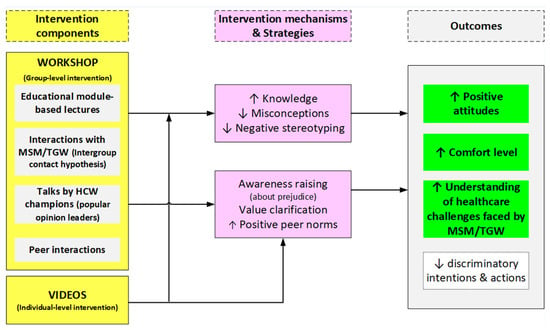
Figure 1
Open AccessArticle
Modulatory Effect of Human Immunodeficiency Virus on Circulating p53, miR-21, and miR-125b: Any Diagnostic Implication?
by
Jude Ogechukwu Okoye, Anthony Ajuluchukwu Ngokere, Chinedum Charles Onyenekwe, Olaposi Idowu Omotuyi, Samuel Ifedioranma Ogenyi, Chioma Maureen Obi and Samuel Ayobami Fasogbon
Venereology 2023, 2(3), 78-85; https://doi.org/10.3390/venereology2030008 - 25 Jun 2023
Abstract
Identifying immunocompromised women who are at risk of developing cervical cancer remains a challenge for clinicians. In an effort to identify the role of HIV in cervical carcinogenesis, this study evaluated the levels of normally downregulated oncomirs (miR-21, miR-146a, miR-155, miR-182, and miR-200c)
[...] Read more.
Identifying immunocompromised women who are at risk of developing cervical cancer remains a challenge for clinicians. In an effort to identify the role of HIV in cervical carcinogenesis, this study evaluated the levels of normally downregulated oncomirs (miR-21, miR-146a, miR-155, miR-182, and miR-200c) and normally upregulated tumor suppressors (miR-let-7b, miR-125b, miR-143, miR-145, and p53 expression) associated with cervical cancer in the serum of women living with HIV (HIV+) and without HIV (HIV. Method: This case-control study included 173 women; confirmed HIV+ (n = 103) and HIV− (n = 70). Serum levels of miRNAs and p53 were determined using reverse transcriptase PCR. t-test and Pearson’s correlation analyses were carried out on the generated data. Result: A higher level of miR-21 was observed among HIV+ women compared with their HIV− counterpart (p = 0.028), whereas lower levels of miR-125, and p53 gene were observed among HIV+ women compared with HIV− women at p = 0.050 and 0.049, respectively. Significant direct relationships were observed between miR-21 and other oncomirs (p < 0.05) among HIV+ women. Conclusion: This study revealed that HIV contributes to cervical carcinogenesis by modulating circulating levels of miR-21, p53, and miR-125b. It suggests that these biomarkers could be used to identify at high risk for developing cervical cancer.
Full article
(This article belongs to the Special Issue Antimicrobial Resistant Sexually Transmitted Infections: Epidemiology, Detection, and Management)
►▼
Show Figures

Figure 1
Open AccessEditorial
The Emerging Threat of Antimicrobial-Resistant Sexually Transmitted Infections: Epidemiology, Management and Detection
by
Karan Varshney
Venereology 2023, 2(2), 76-77; https://doi.org/10.3390/venereology2020007 - 19 May 2023
Cited by 1
Abstract
Antimicrobial resistance (AMR) has become one of the most pressing public health crises, with sexually transmitted infections (STIs) of all types rapidly becoming resistant to treatments [...]
Full article
(This article belongs to the Special Issue Antimicrobial Resistant Sexually Transmitted Infections: Epidemiology, Detection, and Management)
Open AccessReview
Secondary Syphilis: Pathophysiology, Clinical Manifestations, and Diagnostic Testing
by
Shahrukh Chaudhry, Idris Akinlusi, Ted Shi and Jorge Cervantes
Venereology 2023, 2(2), 65-75; https://doi.org/10.3390/venereology2020006 - 11 Apr 2023
Cited by 1
Abstract
►▼
Show Figures
The subspecies T. pallidum pallidum is the cause of the most infamous sexually and congenitally transmitted disease, syphilis. This disease has an estimated incidence of six million infections every year. Multiple studies have noted that the prevalence of syphilis has been steadily increasing
[...] Read more.
The subspecies T. pallidum pallidum is the cause of the most infamous sexually and congenitally transmitted disease, syphilis. This disease has an estimated incidence of six million infections every year. Multiple studies have noted that the prevalence of syphilis has been steadily increasing worldwide in recent decades, especially among MSMs and HIV-positive patients. Clinically, syphilis presents in four stages with multiple different clinical manifestations. In this paper, we examine the current literature to determine the history and progression, pathogenesis, clinical features, and testing of secondary syphilis. Secondary syphilis is a stage of the disease with the most exuberant local and systemic clinical manifestations. The basis of the pathogenesis of SS underscores the unique mechanisms by which Treponema pallidum utilizes to escape immune recognition while simultaneously induces inflammation. SS can affect multiple organ systems and become more than just an STD. The most common presentation of secondary syphilis is rash, which manifests as a copper-colored maculopapular lesion on the trunk, palms, and soles. Although the RPR, VDRL, and FTA-ABS tests are perhaps the most commonly used diagnostic tools for syphilis and make up the traditional and reverse algorithms, there are other methods, including morphology and immunohistochemistry.
Full article
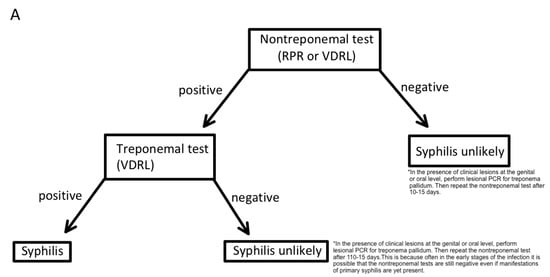
Figure 1
Open AccessBrief Report
Current Trends in Syphilis Mortality in the United States, 2015–2020
by
Noel C. Barragan, Ranjana N. Wickramasekaran, Frank Sorvillo, Lisa V. Smith and Tony Kuo
Venereology 2023, 2(2), 59-64; https://doi.org/10.3390/venereology2020005 - 29 Mar 2023
Abstract
►▼
Show Figures
Rates of reported cases of syphilis have steadily increased since 2000 in the United States. However, despite the increase in cases, mortality from 2000–2014 declined. The following study examines the latest trends in syphilis-related deaths using 2015–2020 Multiple Cause of Death data. A
[...] Read more.
Rates of reported cases of syphilis have steadily increased since 2000 in the United States. However, despite the increase in cases, mortality from 2000–2014 declined. The following study examines the latest trends in syphilis-related deaths using 2015–2020 Multiple Cause of Death data. A total of 925 syphilis-related deaths were identified during the study period, 30% of which listed syphilis as the underlying cause of death. On average, age-adjusted syphilis mortality increased by 9.51% annually (95% CI = 5.41%–13.77%). Study findings indicate a marked increase in deaths attributed to syphilis, underscoring the need to more systematically and comprehensively address the growing sexually transmitted infection epidemic in the United States.
Full article
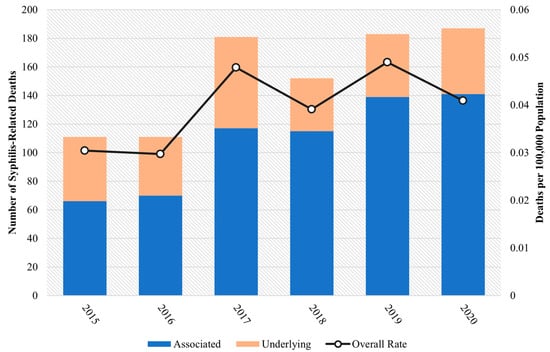
Figure 1
Open AccessReview
School-Based Interventions on Human Papillomavirus in Africa: A Systematic Scoping Review
by
Jimoh Amzat, Kehinde Kazeem Kanmodi, Kafayat Aminu and Eyinade Adeduntan Egbedina
Venereology 2023, 2(1), 43-58; https://doi.org/10.3390/venereology2010004 - 18 Feb 2023
Cited by 3
Abstract
School-age youth constitute a neglected but highly vulnerable group concerning sexual health risks in low-resource countries. Robust evidence concerning the research landscape of school-based interventions on human papillomavirus in Africa is currently lacking. Therefore, this systematic scoping review (SSR) aims to map evidence
[...] Read more.
School-age youth constitute a neglected but highly vulnerable group concerning sexual health risks in low-resource countries. Robust evidence concerning the research landscape of school-based interventions on human papillomavirus in Africa is currently lacking. Therefore, this systematic scoping review (SSR) aims to map evidence about school-based HPV interventions and identify emerging themes, gaps and lessons learned in Africa. This review was guided by Joanna Brigg’s Institute’s guidelines for SSRs and reported based on the Preferred Reporting Items for Systematic Reviews and Metanalysis for Scoping Reviews. Five databases—PubMed, CINAHL, PsycINFO, SCOPUS, and Allied and Complementary Medicine—were searched for relevant literature using appropriate search terms and Boolean operators. The retrieved literature was extracted, deduplicated and screened using the Rayyan software. Only those articles which met the eligibility criteria were included for data charting, collation, and summarization. Ten articles were included in this review. The articles demonstrate that a life-course approach is significant in health intervention. School-based health interventions help reach adolescents in a dynamic life stage, affecting their vulnerability to sexual health risks. The school-based interventions serve as an ideal platform to offer HPV peer education, improving their HPV knowledge and subsequent testing services and enhancing their acceptability for screening and vaccination. Cervical cancer education and screening can be effectively combined in HPV health services for women. While the studies are geographically diverse, such effective interventions, which help reduce bottlenecks in accessing HPV screening and vaccination, are very few in Africa. In conclusion, school-based intervention is a viable strategy that can be adopted for adolescent protection from HPV-induced diseases. However, the current evidence on the impact of these interventions, particularly HPV vaccination, is inadequate.
Full article
(This article belongs to the Special Issue New Advances in Management and Treatment of Sexually Transmitted Infections)
►▼
Show Figures
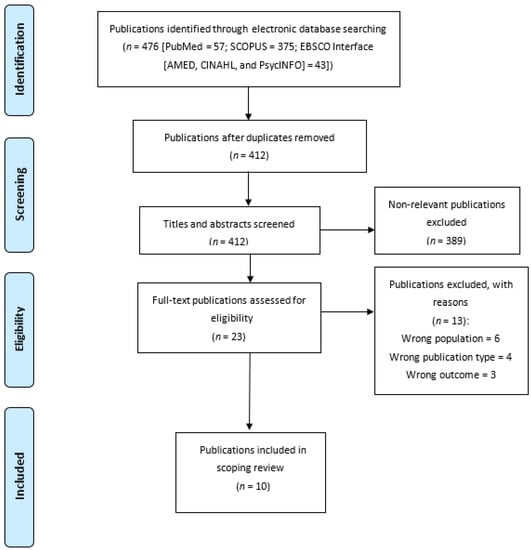
Figure 1
Highly Accessed Articles
Latest Books
E-Mail Alert
News
Topics

Conferences
Special Issues
Special Issue in
Venereology
New Advances in Management and Treatment of Sexually Transmitted Infections
Guest Editor: Alessandro RussoDeadline: 30 April 2024
Special Issue in
Venereology
Antimicrobial Resistant Sexually Transmitted Infections: Epidemiology, Detection, and Management
Guest Editors: Karan Varshney, Michael RossDeadline: 31 July 2024
Special Issue in
Venereology
Exclusive Papers of the Editorial Board Members of Venereology
Guest Editors: Myron Christodoulides, Jacek SzepietowskiDeadline: 31 August 2024




